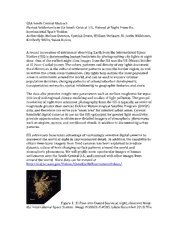
NASA Technical Reports Server (NTRS) 20120001812: Human Settlements in the South-Central U.S., Viewed at Night from the International Space Station PDF
Preview NASA Technical Reports Server (NTRS) 20120001812: Human Settlements in the South-Central U.S., Viewed at Night from the International Space Station
GSA South Central Abstract Human Settlements in the South-Central U.S., Viewed at Night From the International Space Station Authorship: Melissa Dawson, Cynthia Evans, William Stefanov, M. Justin Wilkinson, Kimberly Willis, Susan Runco, A recent innovation of astronauts observing Earth from the International Space Station (ISS) is documenting human footprints by photographing city lights at night time. One of the earliest night-time images from the ISS was the US–Mexico border at El Paso–Ciudad Juarez. The colors, patterns and density of city lights document the differences in the cultural settlement patterns across the border region, as well as within the urban areas themselves. City lights help outline the most populated areas in settlements around the world, and can be used to explore relative population densities, changing patterns of urban/suburban development, transportation networks, spatial relationship to geographic features, and more. The data also provides insight into parameters such as surface roughness for input into local and regional climate modeling and studies of light pollution. The ground resolution of night-time astronaut photography from the ISS is typically an order of magnitude greater than current Defense Meteorological Satellite Program (DMSP) data, and therefore can serve as a “zoom lens” for selected urban areas. Current handheld digital cameras in use on the ISS, optimized for greater light sensitivity, provide opportunities to obtain new detailed imagery of atmospheric phenomena such as airglow, aurora, and noctilucent clouds in addition to documenting urban patterns. ISS astronauts have taken advantage of increasingly sensitive digital cameras to document the world at night in unprecedented detail. In addition, the capability to obtain time-lapse imagery from fixed cameras has been exploited to produce dynamic videos of both changing surface patterns around the world and atmospheric phenomena. We will profile some spectacular images of human settlements over the South-Central U.S., and contrast with other images from around the world. More data can be viewed at http://eol.jsc.nasa.gov/Videos/CrewEarthObservationsVideos/. Figure 1. El Paso and Ciudad Juarez at night, observed from the International Space Station. Image ISS0026-E-8595, taken December 2010. The US-Mexico border is obvious by the different lighting pattern. Not surprisingly, the densely illuminated city of Juarez indicates a higher population; El Paso’s smaller population is spread out over a larger area.
